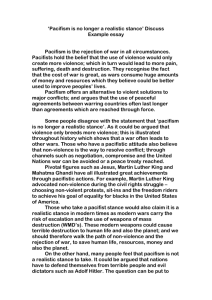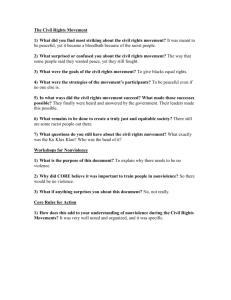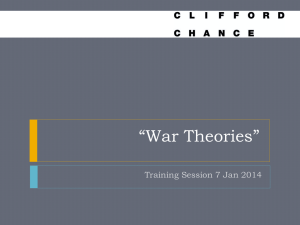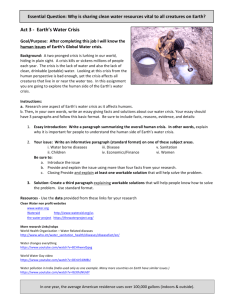PAX 260 Realistic Pacifism Syllabus (Spring 2015) Using the
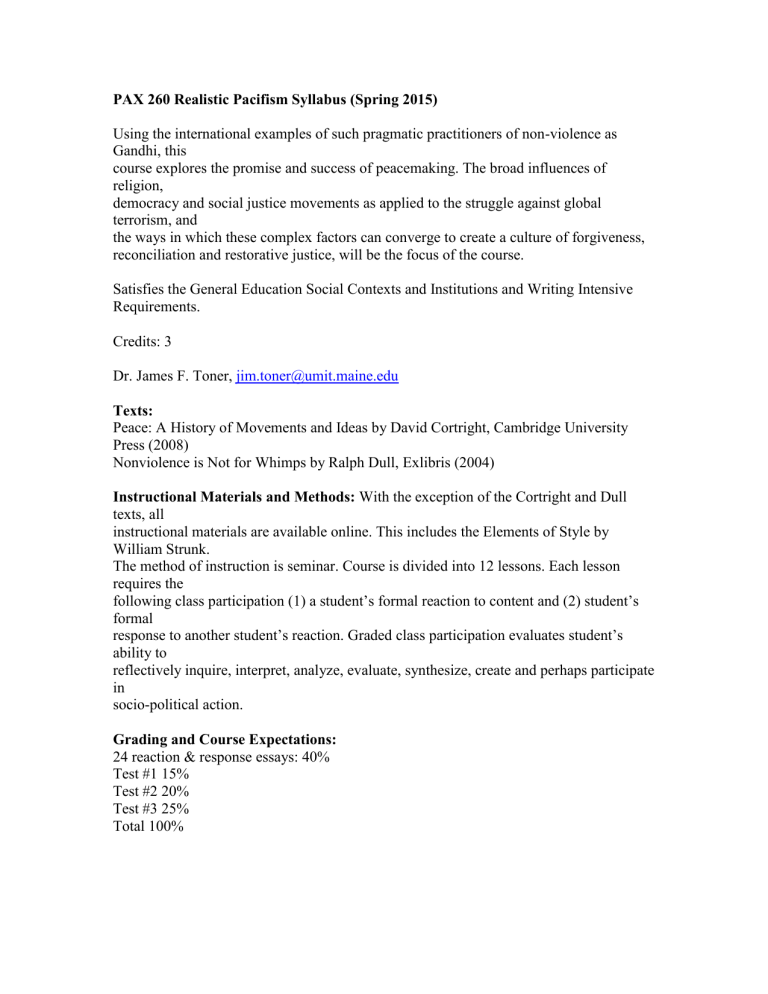
PAX 260 Realistic Pacifism Syllabus (Spring 2015)
Using the international examples of such pragmatic practitioners of non-violence as
Gandhi, this course explores the promise and success of peacemaking. The broad influences of religion, democracy and social justice movements as applied to the struggle against global terrorism, and the ways in which these complex factors can converge to create a culture of forgiveness, reconciliation and restorative justice, will be the focus of the course.
Satisfies the General Education Social Contexts and Institutions and Writing Intensive
Requirements.
Credits: 3
Dr. James F. Toner, jim.toner@umit.maine.edu
Texts:
Peace: A History of Movements and Ideas by David Cortright, Cambridge University
Press (2008)
Nonviolence is Not for Whimps by Ralph Dull, Exlibris (2004)
Instructional Materials and Methods: With the exception of the Cortright and Dull texts, all instructional materials are available online. This includes the Elements of Style by
William Strunk.
The method of instruction is seminar. Course is divided into 12 lessons. Each lesson requires the following class participation (1) a student’s formal reaction to content and (2) student’s formal response to another student’s reaction. Graded class participation evaluates student’s ability to reflectively inquire, interpret, analyze, evaluate, synthesize, create and perhaps participate in socio-political action.
Grading and Course Expectations:
24 reaction & response essays: 40%
Test #1 15%
Test #2 20%
Test #3 25%
Total 100%
Course Infrastructure and Access: This course uses both FirstClass and Blackboard and requires a fast connection to the Internet, e.g. cable or DSL. Please direct all technical questions to cedtechhelp@umit.maine.edu (from outside FirstClass); CED Tech Help (from inside
FirstClass); 1-877-947-HELP (toll free); or 581-4591 (local)
Students will investigate:
1. the charges against pacifism and criticisms of peace advocacy;
2. the strengths and weaknesses of the movements and theories for peace;
3. the case for peace and examine its practices and principles;
4. the responsibility to protect civilians and international humanitarian action;
5. the need to act in the midst of violent conflict;
6. the urgency to stem genocide, repression and terrorism;
7. the difference between negative peace and positive peace;
8. the idea that realistic pacifism is pragmatic and patriotic.
Learning outcomes:
1. Students will deconstruct the term “pacifism”.
2. Students will understand the continuum of pacifism, the meaning of realistic, (i.e. pragmatic or conditional pacifism), and articulate how scholars bridge the gap between pacifism and
“just war.”
3. Students will review the social origins and political agenda of early peace societies.
4. Students will understand the refutation of the claim that peace advocates were responsible for appeasement.
5. Students will understand how anticommunism and an atmosphere of political conformity with a backlash against pacifism undermined progressive internationalism during the cold war.
6. Students will learn to articulate how the proliferation of atomic weapons sparked three waves of disarmament activism.
7. Students will analyze (a) the “war on terror” and (b) efforts by peace advocates to create alternative strategies based on nonviolence and conflict prevention.
8. Students will interpret, analyze and evaluate the role of religion in peacemaking.
9. Students will understand how the Gandhian method of assertive nonviolence has been the key to building a bridge between idealism and pragmatism and creating a realistic pacifism.
10. Students will explore and understand the theoretical and empirical links between democracy
and peace.
11. Students will learn how the rise of socialism and feminism influenced pacifism by focusing on equality and social justice.
12. Students will examine the moral and political imperative of responding to the slaughter of innocents and the responsibility to protect.
13. Students will understand a synthesis among peacemaking traditions giving the principles of nonviolence, forgiveness, reconciliation and restorative justice cardinal importance.
Lessons
1. What is peace and notes on pacifism
Introductory video by David Cortright http://internationalpeaceandconflict.ning.com/video/davidcortright- on-the-50 th
Cortright, Peace, Chapter One
Rosenwald, “Notes on Pacifism,” The Antioch Review, Winter, 2007 http://balkansnet.org/zcl/rosenwald.html
2. The first peace societies and internationalism
Crossland, “Why not pacifism?” http://www.youtube.com/watch?v=xfB_XJYuldQ
Cortright, Peace, Chapters Two and Three
3. Facing facism and debating disarmament
The O’Jays, “For the Love of Money” (Response to Crossland) http://www.stlyrics.com/lyrics/allaboutthebenjamins/fortheloveofmoney.htm
Cortright, Peace, Chapters Four and Five
4. Confronting the cold war and banning the bomb
The Atomic Bombing of Hiroshima and Nagasaki http://www.youtube.com/watch?v=9odsuIcUk5w
Cortright, Peace, Chapters Six and Seven
5. Refusing war but what about Hitler?
Cortright video: "The Legacy of GI Resistance." http://www.youtube.com/watch?v=VIL6Ag8pSgc
Cortright, Peace, Chapter Eight
"Jihad: A Just Struggle or Unjust Violence?" by Zaid Shakir http://www.youtube.com/watch?v=Prmibc9EnHs
Dull, Nonviolence is Not for Whimps, Chapter One
6. Causes, consequences and alternatives to war
Grant Havens on the limits of pacifism http://www.youtube.com/watch?v=tGUi4UhVeIw
Dull, Nonviolence is Not for Whimps, Chapters Two through Nine
7. Cases of successful nonviolence
Dull, Nonviolence is Not for Whimps, Chapters Ten through Thirteen
Pacifist Nation – No Place for Wimps (browse) http://peacehost.net/PacifistNation/stacka.html
3D Dialogue: Ursula Franklin and Pacifism http://www.youtube.com/watch?v=G3qXjG4mzSQ
8. Religion and a force more powerful
Muslims' America -- Arsalan Iftikhar: The Muslim Pacifist Part 1 http://www.youtube.com/watch?v=27FFEan8zpg
Muslims' America -- Arsalan Iftikhar: The Muslim Pacifist Part 2 http://www.youtube.com/watch?v=J2vCG1Xtl6c
Cortright, Peace, Chapters Nine and Ten
8. Democracy and social justice
Howard Zinn on "War and Social Justice"-6/8/2008 http://www.youtube.com/watch?v=94cn4_TmOkY
Cortright, Peace, Chapters Eleven and Twelve
Howard Zinn "Just War" (part 1) http://www.youtube.com/watch?v=Ju1Dr89xbZ4
9. Responsibility to protect and emotions about and experiences in Iraq
Responsibility to Protect http://www.youtube.com/watch?v=zMNNiR3gbgU
Cortright, Peace, Chapter Thirteen
Dull, Nonviolence is Not for Whimps, Chapters Fourteen through Eighteen and
Appendix I.
10. A moral equivalent
Cortright, Peace, Chapter Fourteen
Dull, Nonviolence is Not for Whimps, Appendix Two through Six
11. Realizing disarmament: you can't cut a board with a hammer
Cortright, Peace, Chapter Fifteen
Dull, Nonviolence is Not for Whimps, Appendix Seven through Nine
Cortright, “In This Era of Hope, Obama Must Embrace a Genuine Agenda of Peace.”
12. Realistic, pragmatic and patriotic pacificism
Howard Zinn on Patriotism http://www.youtube.com/watch?v=QCs3nOF964k
Cortright, Peace, Chapter Sixteen
"Is Nonviolence Relevant to the Struggle against Global Terrorism," video by David
Cortright http://video.google.com/videosearch?hl=en&q=David%20Cortright&um=1&ie=UTF-
8&sa=N&tab=wv#
Peace and Collaborative Development Network http://internationalpeaceandconflict.ning.com/
THE REACTION AND RESPONSE CRITERIA
Focus your thinking and writing.
Students will write one reaction essay and one response essay for each of the 12 lessons.
Please limit the content of your reactions and your responses to compact mini-essays of three paragraphs each. See below.
The Reaction Essay
1st Paragraph - INTERPRET- What does/do the source(s) say? In a paragraph of approximately five carefully worded sentences, identify significant points or ideas or aspects of the lesson source(s) that you find particularly relevant to our course theme of "Realistic Pacifism."
This might be a source’s thesis or 1-2 principal points or a dominant theme, but it must be conceptually significant for the lesson as a whole as well as genuinely relevant to our course theme. Translate clearly and concisely in your own words and in a manner that will make it understandable even to someone who has not read the original material. Provide examples from the lesson content as evidence to support your interpretation.
2nd Paragraph – ANALYZE - What does/do the source(s) mean? In another paragraph of about five carefully worded sentences, explain the significance of what you have articulated in your first paragraph, focusing on some specific implication or ramification apropos of our course theme of
"Realistic Pacifism." Then break down or deconstruct the source into component parts so its organizational structure may be understood. Also, continue to express yourself in a manner that will make your explanation clear to someone who has not studied the original material. Provide examples from the lesson content as evidence to support your analysis.
3rd Paragraph – In a final paragraph of about five carefully worded sentences (A)
SYNTHESIZE:
Build a structure or pattern from the diverse lesson sources. Put parts together to form a whole with emphasis on creating a new meaning or construction and (B) EVALUATE: So what? Why do these sources and synthesis matter? Make judgments about the value of ideas or sources.
Why we should care about the implication or ramification you have explained in your analysis and synthesis. Extrapolate beyond the original material and give us something new but relevant (i.e., to our course theme of "Realistic Pacifism") to think about. Make your synthesis and evaluation
clear to someone who has not read the original material. Provide examples from the lesson content to illustrate your synthesis and support your evaluation.
The Response Essay
Identify some particularly enlightening observation(s) or insight(s) or some glaring misinterpretation(s), oversight(s) or faulty judgment(s) you have gleaned from your examination of your classmates’ "reactions."
1. Then, in your first paragraph, in your own words, clearly and concisely articulate the point you choose to address, citing the classmate.
2. In your second paragraph, explain why the point(s) is/are illuminating or faulty. Bring evidence from the lesson content to support your explanation.
3. Finally, in your third paragraph, tell the rest of us why we, as a group examining
"Realistic
Pacifism" should care about the point(s) you have identified and explained.
Student Assessment
Students will investigate the topics and sources in the 12 lessons and complete 24 written assignments and 3 tests. This is a writing intensive course. The principles of composition will apply and influence your essay grade. Students may re-submit up to 6 essays for higher grade after incorporating evaluative feedback. Students must post re-submissions to FirstClass conference not more than one week after receiving graded essay.
A) How professor will grade reaction essays and response essays:
0 = poor or missing assignment (F)
1 = fair (D)
2 = good (C)
3 = very good (B)
4 = excellent (A)
***************************************************************** 0) Poor or missing assignment – shows lack of effort. Does not attempt to follow format or criteria.
Does not have learner outcomes in mind.
1) Fair - Knows the format requirements of the essay, spends time looking over the lesson content, provides minimum effort by summarizing lesson content with little or no interpretation, analysis, synthesis or evaluation.
2. Good - Shows a desire to learn the subject material, will spend time reaching his or her conclusions through interpretation and questioning of his or her own and others beliefs.
Asks and answers “how” and “why” questions. Translates the meaning of primary and secondary sources in his or her own words. Needs to better understand the meaning of analysis, synthesis and evaluation, and to apply that meaning to writing a clear, concise, focused essay supported by evidence found in the lesson sources.
3. Very Good - Gives outstanding effort interpreting, i.e. translating, and analyzing, i.e. deconstructing, sources. Uses evidence from the lesson content to illustrate his or her interpretation and analysis. Understands significance of important concepts and action.
4. Excellent – Superior work interpreting, analyzing and evaluating lesson content.
Synthesizes sources and uses evidence from lesson to create new thesis. Recommends areas for further investigation. Seeks to apply lessons learned.
B) How instructor will construct tests:
Tests will contain questions designed to assess learner outcomes. Professor will design questions to assess interpretation skills and analysis, synthesis and evaluation skills as represented in
Bloom’s Taxonomy. See http://www.nwlink.com/~donclark/hrd/bloom.html
Academic honesty (plagiarism, etc.)
Academic honesty is very important. It is dishonest to cheat on exams, to copy term papers, to submit papers written by another person, to fake experimental results, or to copy or reword parts of books or articles into your own papers without appropriately citing the source.
Students committing or aiding in any of these violations may be given failing grades for an assignment or for an entire course, at the discretion of the instructor. In addition to any academic action taken by an instructor, these violations are also subject to action under the University of Maine Student Conduct Code.
The maximum possible sanction under the student conduct code is dismissal from the
University.
Students with disabilities
If you have a disability for which you may be requesting an accommodation, please contact Ann
Smith, Director of Disabilities Services, 121 East Annex, 581- 2319, as early as possible in the term.


